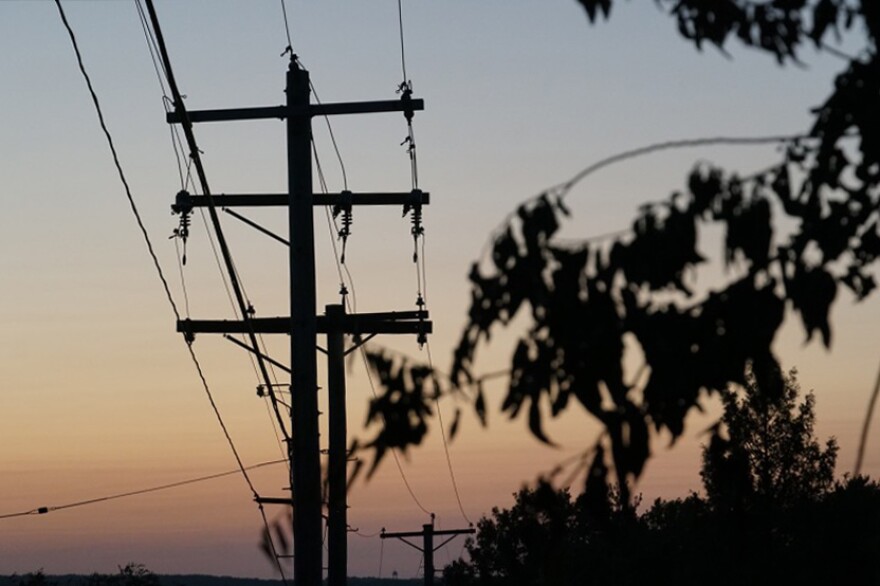Ameren Missouri customers could see an increase in their utility bills early next year, if state regulators approve a proposed rate hike.
The increase in electric and natural gas rates would boost the utility’s yearly revenue by more than $300 million.
Ameren Missouri officials say the revenue would help finance critical upgrades to the electric grid and investments in clean energy, including a new wind generation facility in the northwest corner of the state. But the proposal has come under fire from advocates who argue that raising rates during a pandemic puts already-struggling families at risk of utility disconnection and homelessness.
The Missouri Public Service Commission, a five-member regulatory body appointed by the governor, will hear virtual public testimony on the proposed rate increase beginning Tuesday. Members of the public who wish to provide testimony must sign up in advance.
The utility, which serves more than 1.2 million customers across central and eastern Missouri, has reduced electric rates twice since 2017 — and currently, rates are about 8% lower than they were that year.
Ameren Missouri officials say they’ve been working to keep costs low, especially during the pandemic.
Many customers “are working to recover from the hardships of the pandemic,” said Warren Wood, vice president of regulatory and legislative affairs at Ameren Missouri. “That’s one of the reasons we delayed the filing, so no changes in rates would happen until next year.”
If approved, the increases would cost the average residential customer in Missouri an additional $12 per month for electricity and $4 per month for natural gas, according to a filing submitted to state regulators.
Still, some community advocates worry that even a relatively small increase in utility rates will have a ripple effect throughout low-income communities.
“When you’re already stressed and you have a set income, any little increase can set you back,” said Lora Gulley, director of community mobilization and advocacy at Generate Health. “This [rate] increase could put them at risk for disconnections and certainly lead to eviction.”
Taylor Alexander understands that risk firsthand.
The north St. Louis County mother of four has had her utilities disconnected in the past. With careful budgeting, she hopes it won’t happen again. Her family follows a strict set of rules to conserve energy: unplug appliances when they’re not being used, fill in drafty gaps around the windows, turn off the lights.

But Alexander still feels anxious when her monthly electric bill arrives. Some months, it’s been as high as $180, she said.
“I never thought it would be this difficult financially,” said Alexander, who is taking classes to become a community health care worker. “The worst feeling is when you hear your child say, ‘Mommy, why are the lights not on?’”
Low-income households, particularly in communities of color, spend a greater share of their income on utilities, according to several research studies. A report from the American Council for an Energy-Efficient Economy, for instance, found Black households spend 43% more on energy costs than white households.
The longstanding racial gap in homeownership may be partially responsible for these trends, as well as the age of a city's housing stock. Nearly 60% of homes in the city of St. Louis were built before 1939 and often require costly modifications to be more energy-efficient.
‘It needs to be a just transition’
Wood acknowledges that “there’s no good time to talk about changes in electric rates.”
Still, increased revenue from these rate adjustments will help the utility build a more reliable electric grid, he said, and finance a new wind generation facility in northwestern Missouri.
Ameren Missouri has purchased two wind energy facilities in the past year, as part of a $1.1 billion investment in wind energy statewide. The company plans to reach net-zero carbon emissions by 2050.
“We see the opportunity to transition to cleaner energy and accelerate that effort,” Wood said. “It gets more difficult as you go into the future and probably more expensive. This is really the time to be making those investments to better serve customers.”
Increased revenue will also help offset the cost of retiring coal-fired power plants in Missouri, Wood said.
Beth Gutzler, an environmental justice organizer with Metropolitan Congregations United, sees the value in supporting clean energy projects. But she believes the cost of these initiatives should not be shouldered by low-income and minority communities that spend proportionally more on utilities.
“Even though we know that it's important to make the transition to environmentally friendly practices for our energy, we also know that it needs to be a just transition,” Gutzler said. “Why does the bottom line have to affect people of low income the most? The cost is rolling directly down to consumers from low-income, predominantly Black and brown communities.”
Virtual public hearings in Ameren Missouri’s rate case will be held from Oct. 5 to 8.
Formal evidentiary hearings in Jefferson City will begin in November.
Follow Shahla on Twitter: @shahlafarzan





